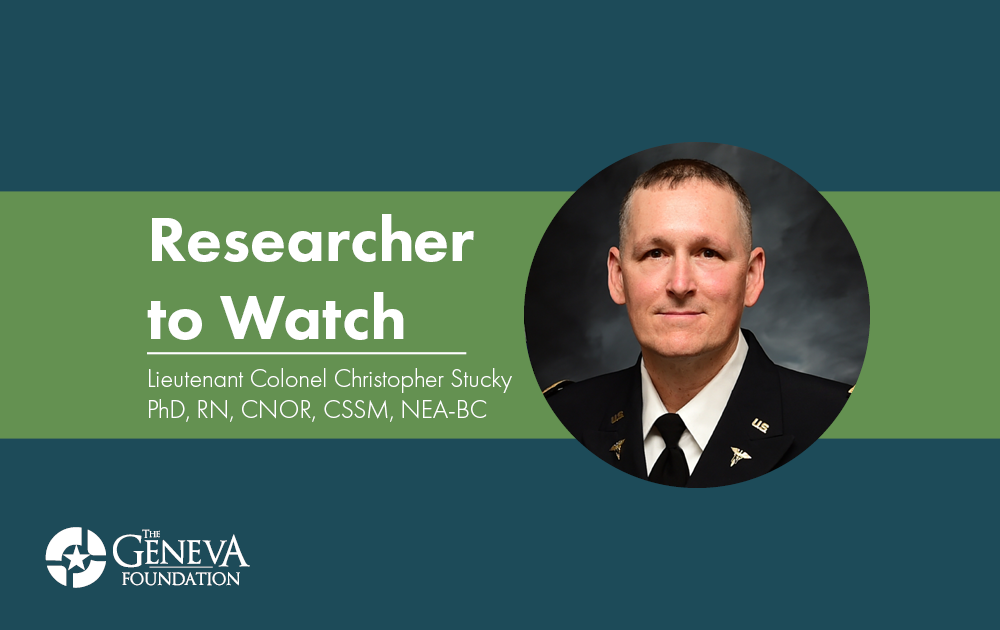4 June 2021
Improving Surgical Team Performance to Improve Healthcare Quality and Safety
Researcher to Watch: LTC Christopher Stucky, PhD, RN, CNOR, CSSM, NEA-BC
Medical errors in hospitals are a frequent occurrence and approximately 200,000 to 400,000 patients die every year from these oftentimes preventable mistakes. This makes medical error the third leading cause of death in the United States, only behind cancer and heart disease. Two-thirds of all errors occur in the operating room (OR) and are most likely due to a breakdown or lack of communication between clinicians involved in surgical procedures. In fact, the Joint Commission, an enterprise that is a global driver of quality improvement and patient safety in healthcare, estimates that nearly 70% of all patient safety events that result in death or serious patient injury are due to communication errors. Geneva Principal Investigator Army Lieutenant Colonel Christopher Stucky, PhD, RN, CNOR, CSSM, NEA-BC has set out to investigate this knowledge gap and advance the understanding of perioperative communication.
LTC Stucky is a Nurse Scientist and Deputy Chief of Research at the Center for Nursing Science and Clinical Inquiry (CNSCI), Womack Army Medical Center at Fort Bragg, NC. He currently serves as the Perioperative Consultant (66E) to the Army Surgeon General and Army Director of the TriService Nursing Research Program (TSNRP) Biobehavioral Research Interest Group (BHRIG). His long-term goal is to develop a comprehensive research program to identify perioperative communication weaknesses, with the aim of increasing healthcare quality and safety. His research interests include network analysis, informatics, systems science, communication, and surgical team performance.
In his most recent study managed by Geneva titled “An Analysis of Perioperative Communication Patterns in a Large Military Medical Center,” LTC Stucky intends to examine the key factors that impact surgical team communication and team performance in a military medical center. Specifically, the research team will implement an exploratory, prospective, cross-sectional, network-centric approach using social network analysis to determine how interdependent clinician relationships influence surgical communication patterns. There are two overall study objectives: (a) to characterize the network factors that influence perioperative clinician communication and (b) to identify how team structure shapes communication effectiveness. The study design allows researchers to identify strengths and weaknesses in communication, revealing the underlying factors that shape communication amongst OR clinicians.
Process improvement and a culture of safety are needed to transform the military health system (MHS) into a high-reliability organization (HRO). “The OR is a key driver for hospital’s fiscal health,” states Dr. Stucky. “To reach the highest levels of interprofessional team performance requires clinicians to communicate critical information accurately and effectively align and coordinate their work with other team members. Effective communication among OR personnel is critical to improved surgical outcomes and the refinement of surgical teams.”
He adds, “Enhancing communication at the organizational and microsystem levels will potentially improve healthcare quality and safety, reduce adverse events, improve readiness, and increase patient satisfaction. Improving the surgical team communication and performance can have an impactful and far-reaching influence on the military health system and is an important step to becoming an HRO.”
LTC Stucky has published two manuscripts as a follow-up to this study – “A Protocol to Examine Surgical Team Communication in a Large Military Medical Center” and “Surgical Team Familiarity: An Integrative Review.”
Disclaimer: The views expressed do not reflect the official policy of the U.S. Army, the Department of Defense, or the U.S. Government.

"Enhancing communication at the organizational and microsystem levels will potentially improve healthcare quality and safety, reduce adverse events, improve readiness, and increase patient satisfaction."
LTC Stucky, PhD, RN, CNOR, CSSM, NEA-BC
HIGHLIGHTS
- Medical errors in hospitals are a frequent occurrence and approximately 200,000 to 400,000 patients die every year from these oftentimes preventable mistakes.
- Geneva Principal Investigator Army Lieutenant Colonel Christopher Stucky, PhD, RN, CNOR, CSSM, NEA-BC has set out to investigate this knowledge gap and advance the understanding of perioperative communication.
- LTC Stucky intends to examine the key factors that impact surgical team communication and team performance in a military medical center.


